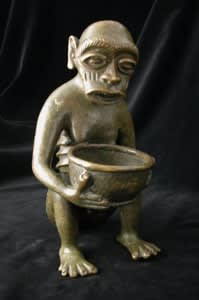Yoruba Brass Sculpture of a Monkey, 20th Century CE
Brass
10.5
PF.6295 (LSO)
This appealing brass figure was made by the Yoruba of Nigeria, and depicts a rather doleful, skeletal monkey, seated and holding a bowl on his lap. The ribs are protuberant,...
This appealing brass figure was made by the Yoruba of Nigeria, and depicts a rather doleful, skeletal monkey, seated and holding a bowl on his lap. The ribs are protuberant, implying starvation. Te qualiry of the rendering is excellent, and the detailing – especially of digits, facial features and texturing – is exquisite. The face is incised with three scars on each side, which exemplifies that it pertains to the Yoruba group. The best-known skeletal monkey forms in Africa are made by the Baule, whose gbreke figures are stark, threatening pieces that are designed to ward away evil and are made more impactive by regular libations of dog blood. This piece, by contrast, while solemn, is charmingly carved and attractive, and is additionally made from metal.
The Yoruba peoples of Nigeria have what is probably the longest extant artistic tradition in Africa. The nation state is comprised of numerous subsections that were joined historically by the rise and collapse of the Ife (12th to 15th centuries) and Benin (13th to 19th centuries) polities. Each of the sub-kingdoms – including Oyo, Ijebu and smaller units towards the west – had their heyday, and are loosely united through language and culture, although they still retain a measure of independence in terms of artistic tradition. It is extremely hard to summarise the nature of Yoruba society given the large area they cover and the inevitable variability of their customs.
The Yoruba – being a large, complex society – is sedentary, agriculturist and hierarchical. They are ruled by hereditary kings known as Obas, and their access to the supernatural world is supervised by a very complex arrangement of priests (i.e. Olowa) and spiritual intermediaries. They also have a deeply established aristocracy and social order, which is reflected in Yoruba artworks. Pieces such as this would have been very expensive to produce and purchase, and while the precise significance of skeletal monkeys is uncertain, it doubtless possessed some specific social import to the Yoruba.
This is a charming piece of African art.
The Yoruba peoples of Nigeria have what is probably the longest extant artistic tradition in Africa. The nation state is comprised of numerous subsections that were joined historically by the rise and collapse of the Ife (12th to 15th centuries) and Benin (13th to 19th centuries) polities. Each of the sub-kingdoms – including Oyo, Ijebu and smaller units towards the west – had their heyday, and are loosely united through language and culture, although they still retain a measure of independence in terms of artistic tradition. It is extremely hard to summarise the nature of Yoruba society given the large area they cover and the inevitable variability of their customs.
The Yoruba – being a large, complex society – is sedentary, agriculturist and hierarchical. They are ruled by hereditary kings known as Obas, and their access to the supernatural world is supervised by a very complex arrangement of priests (i.e. Olowa) and spiritual intermediaries. They also have a deeply established aristocracy and social order, which is reflected in Yoruba artworks. Pieces such as this would have been very expensive to produce and purchase, and while the precise significance of skeletal monkeys is uncertain, it doubtless possessed some specific social import to the Yoruba.
This is a charming piece of African art.
